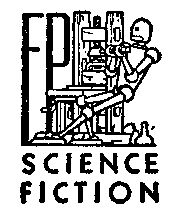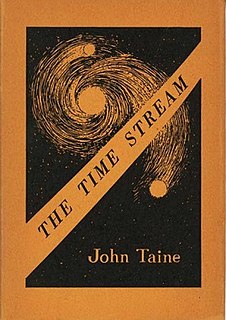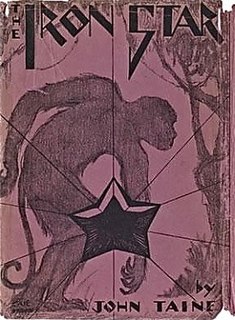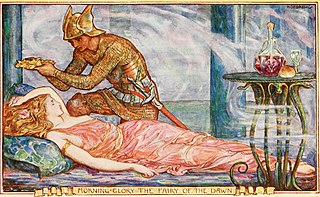
Poul William Anderson was an American science fiction author from the 1940s until the 21st century. Anderson wrote fantasy novels, historical novels, and short stories. His awards include seven Hugo Awards and three Nebula Awards.

Science fiction is a genre of speculative fiction which typically deals with imaginative and futuristic concepts such as advanced science and technology, space exploration, time travel, parallel universes, extraterrestrial life, sentient artificial intelligence, cybernetics, certain forms of immortality, and the singularity. It has been called the "literature of ideas", and it often explores the potential consequences of scientific, social, and technological innovations.

Gene Rodman Wolfe was an American science fiction and fantasy writer. He was noted for his dense, allusive prose as well as the strong influence of his Catholic faith. He was a prolific short story writer and novelist, and won many literary awards. Wolfe has been called "the Melville of science fiction", and was honored as a Grand Master by the Science Fiction and Fantasy Writers of America.
Genre fiction, also known as popular fiction, is a term used in the book-trade for fictional works written with the intent of fitting into a specific literary genre, in order to appeal to readers and fans already familiar with that genre.

Eric Temple Bell was a Scottish-born mathematician and science fiction writer who lived in the United States for most of his life. He published non-fiction using his given name and fiction as John Taine.
Christian science fiction is a subgenre of both Christian literature and science fiction, in which there are strong Christian themes, or which are written from a Christian point of view. These themes may be subtle, expressed by way of analogy, or more explicit. Major influences include early science fiction authors such as C. S. Lewis, while more recent figures include Stephen Lawhead.

The Black Flame is a post-apocalyptic science fiction novel by American writer Stanley G. Weinbaum, originally published in hardcover by Fantasy Press in 1948.

Fantasy Press was an American publishing house specialising in fantasy and science fiction titles. Established in 1946 by Lloyd Arthur Eshbach in Reading, Pennsylvania, it was most notable for publishing the works of authors such as Robert A. Heinlein and E. E. Smith. One of its more notable offerings was the Lensman series.

Phyllis Eisenstein was an American author of science fiction and fantasy short stories as well as novels. Her work was nominated for both the Hugo Award and Nebula Award.
Everett Franklin Bleiler was an American editor, bibliographer, and scholar of science fiction, detective fiction, and fantasy literature. In the late 1940s and early 1950s, he co-edited the first "year's best" series of science fiction anthologies, and his Checklist of Fantastic Literature has been called "the foundation of modern SF bibliography". Among his other scholarly works are two Hugo Award–nominated volumes concerning early science fiction—Science-Fiction: The Early Years and Science-Fiction: The Gernsback Years—and the massive Guide to Supernatural Fiction.

The Forbidden Garden is a science fiction novel by author John Taine. It was first published in 1947 by Fantasy Press in an edition of 3,029 copies.

Seeds of Life is a science fiction novel by American writer John Taine. It was first published in 1951 by Fantasy Press in an edition of 2,991 copies. The novel originally appeared in the magazine Amazing Stories Quarterly in October 1931.

The Crystal Horde is a science fiction novel by American writer John Taine. It was first published in book form in 1952 by Fantasy Press in an edition of 2,328 copies. The novel is substantially rewritten from a version that originally appeared in the magazine Amazing Stories Quarterly in 1930 under the title White Lily.

Deep Space is a collection of science-fiction short stories by the British writer Eric Frank Russell. It was first published by Fantasy Press in 1954 in an edition of 2,257 copies. The stories originally appeared in the magazines Thrilling Wonder Stories, Other Worlds, Astounding, Galaxy Science Fiction, Imagination and Blue book.

The Time Stream is a science fiction novel by American writer John Taine. The novel was originally serialized in four parts in the magazine Wonder Stories beginning in December 1931. It was first published in book form in 1946 by The Buffalo Book Company in an edition of 2,000 copies of which only 500 were ever bound. It is the first novel to see time as a flowing stream.
Fantasy Publishing Company, Inc., or FPCI, was an American science fiction and fantasy small press specialty publishing company established in 1946. It was the fourth small press company founded by William L. Crawford.

The Cosmic Geoids and One Other is a collection of two science fiction novellas by author John Taine. It was first published in 1949 by Fantasy Publishing Company, Inc. in an edition of 1,200 copies. The title novella is a loose sequel to Taine's novel, The Time Stream, and was later serialized in the magazine Spaceway, in three parts beginning in December 1954. The other novella, "Black Goldfish", was first serialized in the magazine Fantasy Book, in two parts beginning in 1948.

The Iron Star is a science fiction novel by American writer John Taine. It was first published in 1930 by E. P. Dutton.

Fantasy is a genre of speculative fiction involving magical elements, typically set in a fictional universe and sometimes inspired by mythology and folklore. Its roots are in oral traditions, which then became fantasy literature and drama. From the twentieth century, it has expanded further into various media, including film, television, graphic novels, manga, animations and video games.

Amazing Stories Quarterly was a U.S. science fiction pulp magazine that was published between 1928 and 1934. It was launched by Hugo Gernsback as a companion to his Amazing Stories, the first science fiction magazine, which had begun publishing in April 1926. Amazing Stories had been successful enough for Gernsback to try a single issue of an Amazing Stories Annual in 1927, which had sold well, and he decided to follow it up with a quarterly magazine. The first issue of Amazing Stories Quarterly was dated Winter 1928 and carried a reprint of the 1899 version of H.G. Wells' When the Sleeper Wakes. Gernsback's policy of running a novel in each issue was popular with his readership, though the choice of Wells' novel was less so. Over the next five issues, only one more reprint appeared: Gernsback's own novel Ralph 124C 41+, in the Winter 1929 issue. Gernsback went bankrupt in early 1929, and lost control of both Amazing Stories and Amazing Stories Quarterly; associate editor T. O'Conor Sloane then took over as editor. The magazine began to run into financial difficulties in 1932, and the schedule became irregular; the last issue was dated Fall 1934.
















